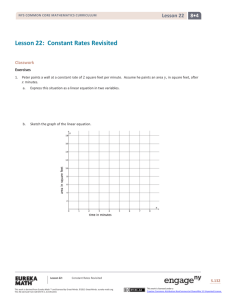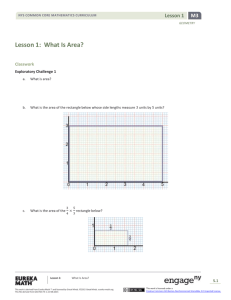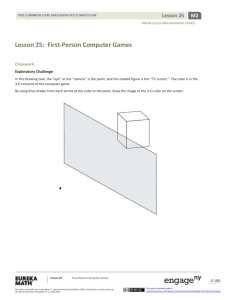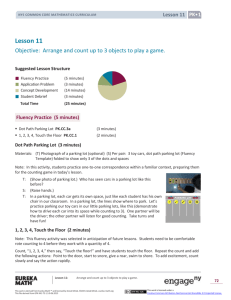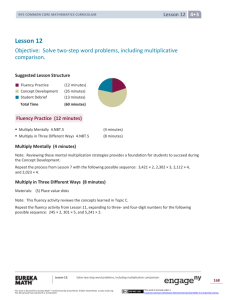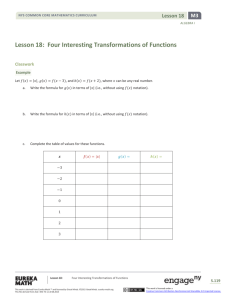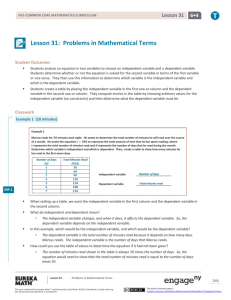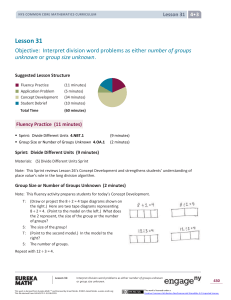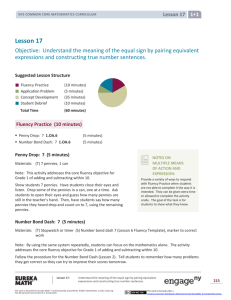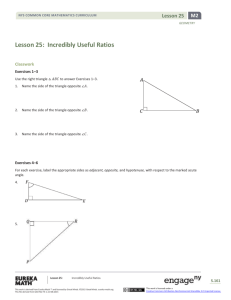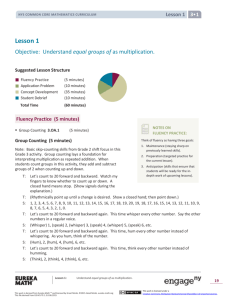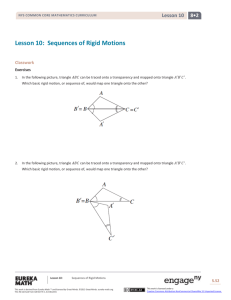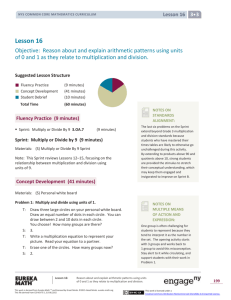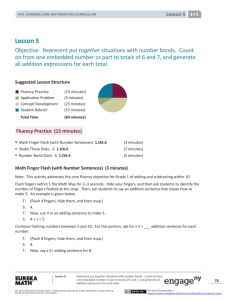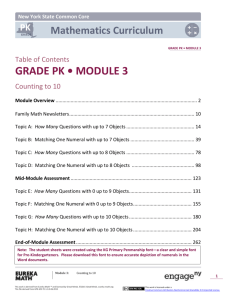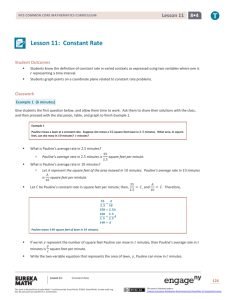2.44 MB - EngageNY
advertisement
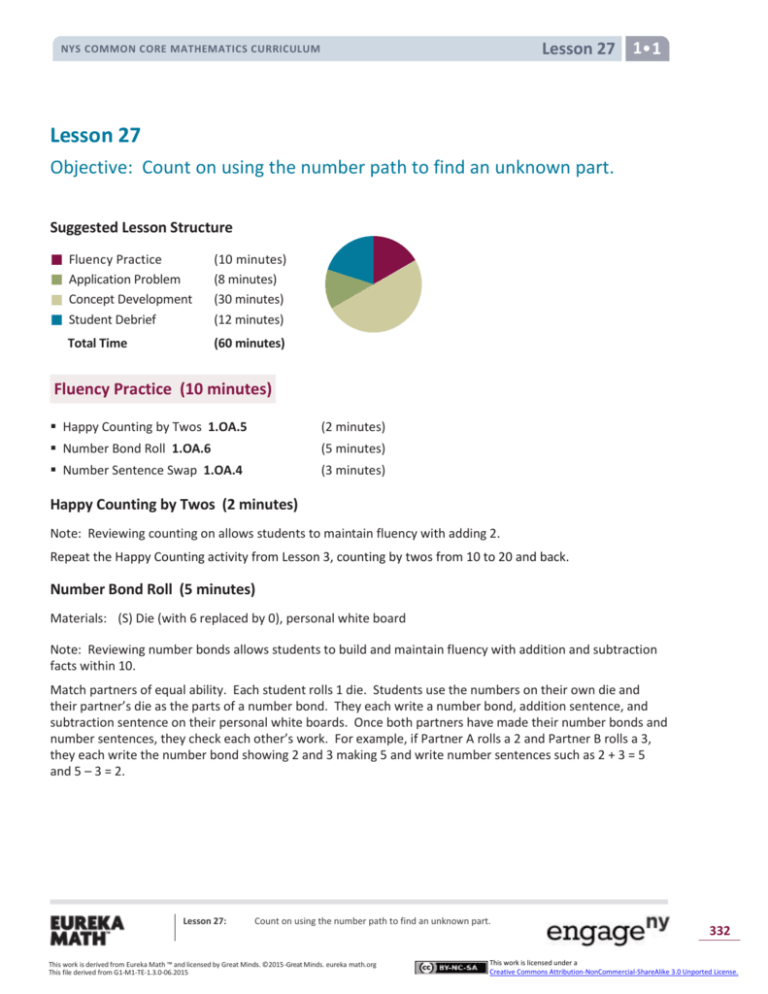
Lesson 27 1 NYS COMMON CORE MATHEMATICS CURRICULUM Lesson 27 Objective: Count on using the number path to find an unknown part. Suggested Lesson Structure Fluency Practice Application Problem Concept Development Student Debrief Total Time (10 minutes) (8 minutes) (30 minutes) (12 minutes) (60 minutes) Fluency Practice (10 minutes) Happy Counting by Twos 1.OA.5 (2 minutes) Number Bond Roll 1.OA.6 (5 minutes) Number Sentence Swap 1.OA.4 (3 minutes) Happy Counting by Twos (2 minutes) Note: Reviewing counting on allows students to maintain fluency with adding 2. Repeat the Happy Counting activity from Lesson 3, counting by twos from 10 to 20 and back. Number Bond Roll (5 minutes) Materials: (S) Die (with 6 replaced by 0), personal white board Note: Reviewing number bonds allows students to build and maintain fluency with addition and subtraction facts within 10. Match partners of equal ability. Each student rolls 1 die. Students use the numbers on their own die and their partner’s die as the parts of a number bond. They each write a number bond, addition sentence, and subtraction sentence on their personal white boards. Once both partners have made their number bonds and number sentences, they check each other’s work. For example, if Partner A rolls a 2 and Partner B rolls a 3, they each write the number bond showing 2 and 3 making 5 and write number sentences such as 2 + 3 = 5 and 5 – 3 = 2. Lesson 27: Count on using the number path to find an unknown part. This work is derived from Eureka Math ™ and licensed by Great Minds. ©2015 -Great Minds. eureka math.org This file derived from G1-M1-TE-1.3.0-06.2015 332 This work is licensed under a Creative Commons Attribution-NonCommercial-ShareAlike 3.0 Unported License. Lesson 27 1 NYS COMMON CORE MATHEMATICS CURRICULUM Number Sentence Swap (3 minutes) Note: This activity supports the connection between subtraction and addition. The initial subtraction sentence, with the unknown number depicted as an empty box, may be written on the board as a visual support if needed. Say a subtraction sentence aloud, saying “the mystery number” for the unknown answer (e.g., “5 – 3 = the mystery number”). Call on a student to rephrase the sentence as an addition sentence (e.g., “3 + the mystery number = 5”). Ask students to count on with you to solve the problem, for example, “3 (touch head), 4 (raise thumb), 5 (raise index finger).” Ask students how many fingers they counted on. (2.) A suggested sequence is 5 – 3, 4 – 2, 6 – 4, 6 – 5, 7 – 6, 7 – 5, and 7 – 3. Application Problem (8 minutes) Materials: (S) Personal white board, number path (Lesson 26 Template) Marcus has 9 strawberries. Six of them are small; the rest are big. How many strawberries are big? Fill in the template. Circle the mystery, or unknown, number in the number sentences, and write a statement to answer the question. Note: This problem is designed as a bridge from the previous lesson’s focus on adding on the number path as a means of solving subtraction problems. Concept Development (30 minutes) Materials: (T) 2 number paths (projected or charted) (S) Personal white board, number path (Lesson 26 Template) Have students bring their personal white boards and sit in a semicircle facing a projected number path. T: S: T: S: T: NOTES ON MULTIPLE MEANS OF ENGAGEMENT: Some students may feel more comfortable moving forward in small steps with frequent opportunities to practice what they are learning. Not all students will be able to determine if they should count on or count back right away. Support the way they are solving the problems, and encourage them to eventually be able to choose the method that is most efficient. (Write 9 – 8 = ☐ on the board, and read the equation aloud with students.) Fill in your number bond using this number sentence. One of the boxes should be left empty. (Write 9 in the total box and 8 in the part box.) What are some ways we can solve this? Talk with your partner. (Share with a partner.) (Circulate and listen. Then, ask a student or two to share with the class.) Lesson 27: Count on using the number path to find an unknown part. This work is derived from Eureka Math ™ and licensed by Great Minds. ©2015 -Great Minds. eureka math.org This file derived from G1-M1-TE-1.3.0-06.2015 333 This work is licensed under a Creative Commons Attribution-NonCommercial-ShareAlike 3.0 Unported License. Lesson 27 1 NYS COMMON CORE MATHEMATICS CURRICULUM We can add! We can count on using the number path! We can count back! I heard someone say that we can count back. Let’s use the number path to count back and solve 9 – 8 = ☐. Which way should we hop to show taking away 8? How many times? S: Hop backward 8 times. T: Let’s start with our whole, and count as we draw our hopping marks. T/S: 1, 2, 3, 4, 5, 6, 7, 8. T: What is 9 – 8? S: 1. T: Yes. Write that in your number bond, solve your number sentence, and circle the unknown or answer number we were solving for. S: (Write 1 in the other part box, solve, and circle 1.) T: We counted back 8 from 9 until we reached 1. Wow, that took us a long time! Hmmm, is there a faster way to solve this? I heard someone say that we can add instead. So, if we think addition, what addition sentence could we write to help us solve 9 – 8 = ☐? S: 8 + ☐= 9. T: Good. Please write that number sentence. (Pause.) Let’s use our number paths to solve 9 – 8 =☐ by thinking of 8 + ☐= 9. T/S: (Circle 8, and draw an arced arrow to 9 as everyone counts.) Eeiiiight, 9. T: How many did we count on in order to solve? S: 1. T: Yes. Please solve your number sentence, and circle the unknown or answer number we were solving for. S: (Solve and circle 1.) T: Look at these two strategies to solve the same NOTES ON problem, 9 – 8 = ☐. Talk with your partner. Did we get the same answer each time? Which way was more MULTIPLE MEANS efficient, or faster? OF REPRESENTATION: T: (As students talk, circulate and listen. Then, ask a During this lesson it is important for student or two to share and explain why.) students to articulate the way they chose to solve a problem so that other S: Counting on was more efficient, because we only had students can hear how they are to count on 1 more. Counting back took so much thinking. This should help guide these longer, and we still got 1 as our unknown, or answer students toward the most efficient number. method for solving subtraction T: So, when you are solving subtraction number problems. sentences, you can think and decide: “Would it be easier for me to count back or count on?” S: T: MP.7 Lesson 27: Count on using the number path to find an unknown part. This work is derived from Eureka Math ™ and licensed by Great Minds. ©2015 -Great Minds. eureka math.org This file derived from G1-M1-TE-1.3.0-06.2015 334 This work is licensed under a Creative Commons Attribution-NonCommercial-ShareAlike 3.0 Unported License. Lesson 27 1 NYS COMMON CORE MATHEMATICS CURRICULUM Continue this process, having students show the strategies on their own personal boards, just as in Lesson 26. Consider using the following suggested sequence: 7 – 6, 9 – 2, 8 – 3, and 10 – 7. Focus students on explaining why they would select a particular method, ensuring that they cite efficiency in some way. Problem Set (10 minutes) Students should do their personal best to complete the Problem Set within the allotted 10 minutes. For some classes, it may be appropriate to modify the assignment by specifying which problems they work on first. Some problems do not specify a method for solving. Students solve these problems using the RDW approach used for Application Problems. Student Debrief (12 minutes) Lesson Objective: Count on using the number path to find an unknown part. The Student Debrief is intended to invite reflection and active processing of the total lesson experience. Invite students to review their solutions for the Problem Set. They should check work by comparing answers with a partner before going over answers as a class. Look for misconceptions or misunderstandings that can be addressed in the Debrief. Guide students in a conversation to debrief the Problem Set and process the lesson. Any combination of the questions below may be used to lead the discussion. What strategy did you use for Problem 10(a)? Why? Problem 10(b)? Problem 10(c)? What is different about Problem 10(f)? Is there one best way to solve it? (No. Counting on and counting back are the same. It depends on individual preference.) What did you notice about the times you chose to count on? When you counted back? What other strategies could you have used to solve these subtraction sentences? Lesson 27: Count on using the number path to find an unknown part. This work is derived from Eureka Math ™ and licensed by Great Minds. ©2015 -Great Minds. eureka math.org This file derived from G1-M1-TE-1.3.0-06.2015 335 This work is licensed under a Creative Commons Attribution-NonCommercial-ShareAlike 3.0 Unported License. Lesson 27 1 NYS COMMON CORE MATHEMATICS CURRICULUM Look at Problem 8 and Problem 9. Would you have preferred to count up or back? Why? Which is more efficient, and how do you know? What about if we had 117 – 115? Should we count on or back? What would our answer be? Exit Ticket (3 minutes) After the Student Debrief, instruct students to complete the Exit Ticket. A review of their work will help with assessing students’ understanding of the concepts that were presented in today’s lesson and planning more effectively for future lessons. The questions may be read aloud to the students. Lesson 27: Count on using the number path to find an unknown part. This work is derived from Eureka Math ™ and licensed by Great Minds. ©2015 -Great Minds. eureka math.org This file derived from G1-M1-TE-1.3.0-06.2015 336 This work is licensed under a Creative Commons Attribution-NonCommercial-ShareAlike 3.0 Unported License. Lesson 27 Problem Set 1 NYS COMMON CORE MATHEMATICS CURRICULUM Name Date 1 2 3 4 5 6 7 8 9 10 Rewrite the subtraction number sentence as an addition number sentence. Place a ☐ around the unknown. Use the number path if you want to. 1. 4–3= _____ + _____ = ______ 2. 6–2= _____ + _____ = ______ 3. 7–3= _____ + _____ = ______ 4. 9–6= ____________________ 5. 10 – 2 = ____________________ Use the number path to count on. 6. 8 – 4 = ______ 4 + ______ = 8 7. 9 – 5 = ______ 5 + ______ = 9 Lesson 27: Count on using the number path to find an unknown part. This work is derived from Eureka Math ™ and licensed by Great Minds. ©2015 -Great Minds. eureka math.org This file derived from G1-M1-TE-1.3.0-06.2015 337 This work is licensed under a Creative Commons Attribution-NonCommercial-ShareAlike 3.0 Unported License. Lesson 27 Problem Set 1 NYS COMMON CORE MATHEMATICS CURRICULUM 1 2 3 4 5 6 7 8 9 10 Hop back on the number path to count back. 8. 10 – 1 = ______ 9. 9 – 2 = ______ 10. Pick the best way to solve the problem. Check the box. Count on Count back a. 10 – 9 = _____ b. 9 – 1 = _____ c. 8 – 5 = _____ d. 8 – 6 = _____ e. 7 – 4 = _____ f. 6 – 3 = _____ Lesson 27: Count on using the number path to find an unknown part. This work is derived from Eureka Math ™ and licensed by Great Minds. ©2015 -Great Minds. eureka math.org This file derived from G1-M1-TE-1.3.0-06.2015 338 This work is licensed under a Creative Commons Attribution-NonCommercial-ShareAlike 3.0 Unported License. NYS COMMON CORE MATHEMATICS CURRICULUM Name Lesson 27 Exit Ticket 1 Date To solve 7 - 6, Ben thinks you should count back, and Pat thinks you should count on. Which is the best way to solve this expression? Make a simple math drawing to show why. 7 - 6 = __________ Lesson 27: Count on using the number path to find an unknown part. This work is derived from Eureka Math ™ and licensed by Great Minds. ©2015 -Great Minds. eureka math.org This file derived from G1-M1-TE-1.3.0-06.2015 339 This work is licensed under a Creative Commons Attribution-NonCommercial-ShareAlike 3.0 Unported License. Lesson 27 Homework 1 NYS COMMON CORE MATHEMATICS CURRICULUM Name Date Use the number path to complete the number bond, and write an addition and a subtraction sentence to match. 1. Number Path 1 a. 2 3 4 5 6 b. 10 7 8 9 10 10 6 3 2. Solve the number sentences. Pick the best way to solve. Check the box. Count on Count back a. 9 – 7 = ______ b. 8 – 2 = ______ c. 7 – 5 = ______ Lesson 27: Count on using the number path to find an unknown part. This work is derived from Eureka Math ™ and licensed by Great Minds. ©2015 -Great Minds. eureka math.org This file derived from G1-M1-TE-1.3.0-06.2015 340 This work is licensed under a Creative Commons Attribution-NonCommercial-ShareAlike 3.0 Unported License. Lesson 27 Homework 1 NYS COMMON CORE MATHEMATICS CURRICULUM 3. Solve the number sentence. Pick the best way to solve. Use the number path to show why. Count on Count back a. 7 – 5 = _____ 1 2 3 4 5 6 7 8 9 10 I counted _____________ because it needed fewer hops. b. 9 – 1 = _____ 1 2 3 4 5 6 7 8 9 10 I counted _____________ because it needed fewer hops. c. 10 - 8 = ___ Make a math drawing or write a number sentence to show why this is best. Lesson 27: Count on using the number path to find an unknown part. This work is derived from Eureka Math ™ and licensed by Great Minds. ©2015 -Great Minds. eureka math.org This file derived from G1-M1-TE-1.3.0-06.2015 341 This work is licensed under a Creative Commons Attribution-NonCommercial-ShareAlike 3.0 Unported License.



